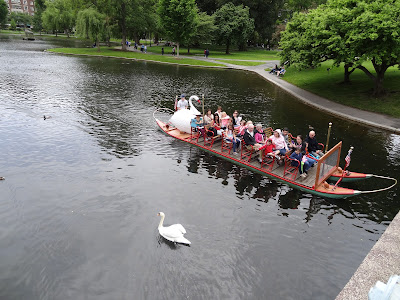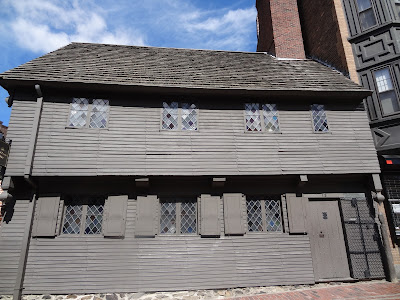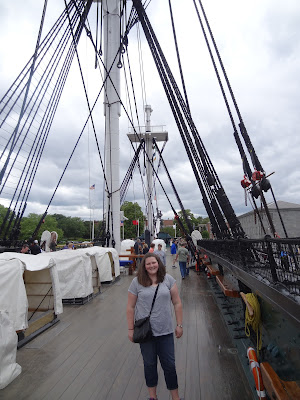Nearby city: Boston, MA
“He said to his friend, If the British march by land or sea from the town tonight
Hang a lantern aloft in the belfry arch of the North Church tower as a signal light —
One, if by land, and two, if by sea;
And I on the opposite shore will be,
Ready to ride and spread the alarm
Through every Middlesex village and farm,
For the country folk to be up and to arm.”
-from “Paul Revere’s Ride” (1860) by Henry Wadsworth Longfellow
Beantown, the City on a Hill, The Cradle of Liberty...Boston. The story of Boston is the story of American independence, revolution and the birthplace of our country. The Boston National Historical Park protects a number of areas in the city that were important and pivotal in the founding of the nation. These sites are connected by the Freedom Trail, a pleasant 2.5 mile walking path, marked with red brick that makes it easy for tourists to follow.
The sites along the path are: Boston Common, Massachusetts State House, Park Street Church, Granary Burying Ground, King’s Chapel and Burying Ground, Benjamin Franklin statue and former site of Boston Latin School, Old Corner Bookstore, Old South Meeting House, Old State House, site of the Boston Massacre, Faneuil Hall, Paul Revere House, Old North Church, Copp’s Hill Burying Ground, the USS Constitution, and the Bunker Hill Monument.
Most of these sites are free, but the Old South Meeting House, the Old State House, and the Paul Revere House charge admission.
Settled in 1630 by Puritans from Charlestown searching for a fresh water source, Boston is one of the oldest towns in the country. Boston’s setting on a natural harbor where the Charles River empties into the Massachusetts Bay and the Atlantic Ocean, made it a key trading hub and a center for the shipping and fishing industries. Boston was the largest city in the British colonies in North America until the mid 1700s when it was surpassed by New York City and Philadelphia.
Boston is a must-visit for anyone who loves American history. We walked the Freedom Trail, it was great to learn about the story of the American revolution, and walk in the footsteps of such luminaries as Paul Revere and other Founding Fathers. We started our day in the Boston Common, a beautiful city park, and the beginning of the Freedom Trail.
Established in 1634, Boston Common is the oldest city park in the United States. Just across the street from the park, is the famous spot that served as the exterior shot for the bar in the TV sitcom “Cheers.” Although not part of the NPS, it’s a cool spot and I’m a big fan of the show. Take some time to see the place where “everybody knows your name.” 😀😀
The next stop is the Massachusetts State House, built in 1798. It contains the offices of the Governor and other important executive officials, and is where the State House and State Senate meet.
Next up is the Park Street House. Built in 1809, it is a Conservative Congregational Church and was the tallest building in the United States from 1810 to 1828. The Church is right next to the Granary Burying Ground, the final resting place for many patriots, such as Paul Revere, and three signers of the Declaration of Independence: John Hancock (who famously signed in large letters so that King George could see it without putting on his spectacles), Samuel Adams, and Robert Treat Paine.
King’s Chapel, completed in 1754, is one of the great examples of colonial architecture and designed by noted architect Peter Harrison. Known as the “Stone Chapel” during the revolution, it was the meeting place for a Christian Unitarian congregation.
The Old South Meeting House, built in 1729, served as a Congregational Church. It was the famous meeting point where the Boston Tea Party was organized on December 16, 1773.
Next up is one of the highlights of the Freedom Trail, the Old State House. Built in 1713, it was the seat of the Massachusetts General Court, and is one of the oldest public buildings in the country. The building was also home to the Massachusetts Supreme Judicial Court and the Massachusetts Assembly. After the revolution, the building served as the seat of state government until 1798.
On March 5, 1770 the Boston Massacre occurred in front of the building. Tensions between colonists and British soldiers stationed in Boston had been building for years. It’s not entirely known how the violence started, but a mob of colonists started to form around a British soldier standing guard at the Old State House. Other soldiers arrived and tried to disperse the crowd. The crowd started to throw snowballs and other objects at the soldiers and taunting them to fire. Finally, a thrown object struck British Private Montgomery, knocking him down to the ground and causing him to drop his musket. Montgomery recovered his weapon and yelled “Damn you, fire!” and fired indiscriminately into the gathered crowd. More volleys from the British soldiers followed. At the end of the day, 5 colonists had died, and 6 wounded. Among the dead was Crispus Attucks, a freed slave of African and Native American descent. Contemporaries considered him a martyr in the cause of freedom, and he is usually considered the first casualty of the Revolution.
Eight British soldiers and their commanding officer, Captain Preston, were charged and indicted with murder. No attorney in Boston had any interest in defending the soldiers on these charges, but John Adams bravely took the challenge. John Adams was a prominent attorney and was a well-known opponent of the Stamp Act and other taxes enacted by the British authorities. Although Adams generally supported independence and knew taking the case would likely damage his reputation, Adams had a strong belief that those accused of a crime had a right to zealous representation and a fair trial. During opening arguments to the jury, Adams pleaded that “facts are stubborn things; and whatever may be our wishes, our inclinations, or the dictates of our passion, they cannot alter the state of facts and evidence.” Six of the soldiers and Capt. Preston were acquitted by the jury, and two were convicted on a lesser charge of manslaughter. Patriots respected Adams’ integrity in conducting the defense, and Adams would be a strong proponent for liberty and independence in the Revolution, and would go on to serve as the first Vice President and second President of the United States.
Samuel Adams, John Adams’s cousin and a bit more of a firebrand than him, referred to the incident as the “Boston Massacre” and made sure that the event would not leave the public consciousness by holding annual commemorations. The Boston Massacre was crucial to turning colonial sentiment against British authority and fostered support for the Patriot cause.
On July 18, 1776, the first public reading of the Declaration of Independence was done on the balcony of the Old State House. This site might be one of the most important places in the birth of the nation.
The balcony where the Declaration of Independence was first proclaimed to jubilant crowds.
The next stop is Faneuil Hall. Built in 1743, it functioned as a marketplace and meeting hall. It was the site of many speeches by Samuel Adams, James Otis (who coined the phrase “Taxation without Representation is tyranny”) and other champions of liberty and independence.
Take some time to shop and get lunch in the marketplace. We ate at the Bell in Hand Tavern. Built in 1795, it is perhaps the oldest operating bar and eatery in the entire country. We cooled down from the hot summer sun with drinks and oysters, just like the patriots of yesteryear did.
Next up is the home of Paul Revere. Paul Revere was a silversmith and member of the Sons of Liberty, a secret organization that protested British taxation measures and championed the cause of freedom and independence.
The home was built sometime around 1680. No pictures allowed inside the home, but make sure to take the tour.
By April 1775, the Sons of Liberty got word that the British Army was planning to crackdown on the rebellious Massachusetts Provincial Congress, meeting in the town of nearby Concord. Paul Revere and William Dawes were assigned to alert the militia (the “minutemen”) when British forces began the march. They planned for Robert Newman, a sexton at the nearby Old North Church, to light a lantern in the Church’s tower (one light if the British forces advanced by land; and two if by sea). Once they saw the light, Revere and Dawes ferociously rode their horses on a “midnight ride” to alert colonists in Charlestown that “the British are coming! The British are coming!” (This is of course the popular phrase used by Longfellow, Revere actually said something along the lines of “the Regulars are coming out!”). Thanks to Revere’s effort, the Patriots were ready to engage with the British Army at Lexington and Concord, the first battles of the Revolutionary War.
The Old North Church was built in 1723 and is the oldest standing church building in Boston. The church is a mission of the Episcopal Diocese of Massachusetts. It’s a beautiful building inside, take some time to go through the pews. One of the pews was famously visited by Theodore Roosevelt.
Now cross the river and see the USS Constitution (aka “Old Ironsides”). The Constitution is a wooden hulled, three-masted heavy frigate. The ship was launched in 1797, one of the six original frigates of the US Navy. She is the oldest commissioned naval vessel in the entire world that is still afloat. It saw action in the Barbary Wars and the War of 1812 (where she defeated 5 British warships), and was retired from active service in 1881. To this day, she is served by a crew of 60 active-duty officers and sailors. The ship now serves as a “floating museum” and is well worth a visit.
The last stop on the Freedom Trail is the memorial to the Battle of Bunker Hill. The earliest major battle of the Revolutionary War, fought on June 17, 1775. British troops in Boston started to venture out to nearby hills outside of Boston, in order to secure control of the entire harbor. Colonist forces had constructed a redoubt on Breed’s Hill on Charlestown peninsula, north of town. *(most of the fighting occurred on Breed’s Hill, but for whatever reason, the battle was named after nearby Bunker Hill)*
The militia was low on supplies and ammo, so as the British approached, William Prescott famously ordered the colonists not to fire until they could see “the whites of their eyes.” The Patriots fought valiantly, but they were pushed off the hills outside Boston and retreated. However, the British victory was costly. They had lost 1,054 compared to the 450 lost on the American side. After the battle, the British knew that the upstart, rag-tag colonists would be a formidable foe.
No visit to Boston would be complete without walking the entirety of the Freedom Trail to learn about the history of our great nation. More info here: https://www.nps.gov/bost/index.htm




































































No comments:
Post a Comment